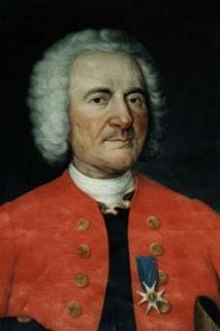Amédée-François Frézier
| Amédée-François Frézier | |
|---|---|
 |
|
| Born | 1682 Chambéry, Savoy, France |
| Died | October 26, 1773 Brest, Britanny, France |
| Occupation | Engineer, mathematician, spy, explorer |
| Parent(s) | Pierre-Louis Frézier |
Amédée-François Frézier (1682 – October 26, 1773) was a French military engineer, mathematician, spy, and explorer who is best remembered for bringing back five specimens of Fragaria chiloensis, the beach strawberry, from an assignment in South America, thus introducing this New World fruit to the Old.
As described by G.M. Darrow, Frézier's ancient surname was derived from fraise, the French word for strawberry. A story relates the surname is derived from the fact that Julius de Berry, a citizen of Anvers (i.e. Antwerp), was knighted by Charles the Simple in 916 for a timely gift of ripe strawberries. The Emperor gave the Fraise family (the surname was corrupted as "Frazer") three "fraises" or stalked strawberries for their coat of arms.
Members of the Frazer family emigrated to Scotland as members of the retinue of the French ambassador, who had been sent by Henry I of France as a gesture of friendship to Malcolm III of Scotland, the vanquisher of Macbeth. For the services against the invading Danes, King Máel Coluim (Malcolm) rewarded the Frazers with grants of land and a coat of arms – which contained the original crest of three strawberries (see Clan Fraser).
Édouard Frazer returned to France from Edinburgh around 1500 to escape Scottish political troubles, taking refuge in Amsterdam. The son of Édouard was Charles-Simon, who settled in France. Charles-Simon's descendants later settled in Savoy.
Amédée-François Frézier was born in Chambéry, Savoy, in 1682. Frézier's father, Pierre-Louis Frézier, a distinguished attorney of law, professor, and advisor to the Duke of Savoy at Chambéry, intended his son to follow him in the law. However, Frézier resisted this career path and was sent instead to study science and theology at Paris. His thesis was entitled Treatise on Navigation and the Elements of Astronomy. After completing his scientific studies, Frézier traveled to Italy where he studied art and architecture –interests he later applied to his study of fortresses and defense structures. He returned to France around 1700 and accepted a lieutenantship in an infantry regiment.
...
Wikipedia
